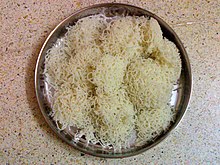Idiyappam
 Cooked idiyappams on a plate | |
| Type | breakfast |
|---|---|
| Place of origin | India |
| Main ingredients | rice flour |
| Similar dishes | Putu mayam |
Idiyappam (Tamil: இடியாப்பம்),(Malayalam: ഇടിയപ്പം), (Sinhala: ඉඳි ආප්ප) also known as Semige or Semé da Addae (Tulu),Shavige (ಶಾವಿಗೆ) in Kannada, Nooputt (or Noolputtu)(Kodava: ನೋಲ್ ಪೂಟ್ಟ್), Putumayam (in Malaysia) or string hoppers is a traditional Tamil, Kerala, Kodava, Tulu and Sri Lankan food consisting of rice flour pressed into noodle form and then steamed.
History
"The Story of our Food", a book written by K. T. Achaya, an eminent Indian food scientist and food historian, states that Idiyappam and Appam were already known in ancient Tamil country around 1st century AD, as per references in the Sangam literature.[1]
Distribution
Idiyappam is culinary specialty in Tamil Nadu, Kerala, Sri Lanka and southern areas of Karnataka (especially in the districts of Dakshina Kannada, Udupi and Kodagu) . It is also a culinary staple in Sri Lanka. The name idiyappam derives from the Tamil/Malayalam words idi, meaning 'broken down', and appam, meaning "pancake". Pronounced as e-di- ap-pam The dish is also, frequently, called noolappam or noolputtu from the Malayalam/Tamil/Kannada/Kodava word nool, meaning "string or thread", especially in Kodagu. In coastal areas of Karnataka like Mangalore and Udupi it is also termed semige or semé da addae in Tulu ,it is eaten with Tuluva chicken and fish curries called Gassi, and also a coconut milk dish called Rasayana . [2] It is common in Malaysia, where it is called putumayam.
Method of preparation
It is made of rice flour or ragi flour (Finger millet flour), salt and water. It is generally served as the main course at breakfast or dinner together with a curry (potato, egg, fish or meat curry) and coconut chutney. It is served with coconut milk and sugar in Sri Lanka and in the Malabar region of Kerala. It is not usually served at lunch. In other parts of Kerala and Tamil Nadu, it is mostly eaten with spicy curries. Using wheat flour in its preparation gives it a brownish hue.
Mix rice flour with hot water, optionally add ghee, season with salt. Knead into a smooth dough. Fill an 'idiyappam' press or a sieve with the dough and press the noodles onto banana leaves or directly into an idli steamer. Add a little grated coconut if desired. Steam for 5–10 minutes. The idiyappam is served with coconut gratings and coconut milk.[3][4][5]
See also
References
- ^ K. T. Achaya. The Story of Our Food. Universities Press. p. 80. ISBN 81-7371-293-X.
- ^ "Idiyappam". Marias Menu. Retrieved 12 April 2014.
- ^ Wickramasinghe and Rajah (2005). Food of India. Murdoch books.
- ^ 50 of the Best: 30-minute Meals. Murdoch books. 1 January 2012.
- ^ Vairavan (2010). Chettinad kitchen. Westland. p. 64.
